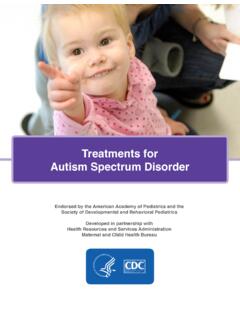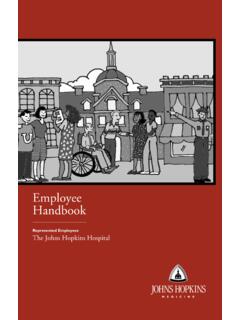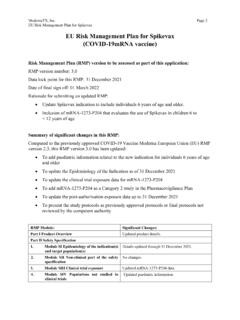Transcription of MODULE 10: PHARMACOVIGILANCE - World Health …
1 MODULE 10: PHARMACOVIGILANCE WHO/Petterik Wiggersn1681. INTRODUCTIONThis section introduces the concepts of PHARMACOVIGILANCE and adverse drug reactions, discusses the burden of adverse drug reactions for children and explains the importance of PHARMACOVIGILANCE in the context of antiretroviral therapy (ART). Defining pharmacovigilanceWHO defines PHARMACOVIGILANCE as the science and activities related to the detection, assessment, understanding and prevention of adverse effects or any other possible drug-related problem (1). It focuses on investigating and monitoring adverse drug reactions after medicinal products are licensed (2). Adverse drug reactions are a response that is noxious and unintended and that occurs at doses normally used in humans for the prophylaxis, diagnosis or therapy of disease or for modifying physiological function (2).
2 They may vary in presentation and occurrence and are commonly divided into type A (augmented pharmaceutical response) and type B (bizarre or hypersensitivity) adverse drug reactions (3).An example of a type A reaction in relation to antiretroviral (ARV) drugs for treating HIV is the negative effect of tenofovir on bone mineral density, which may increase fracture risk (4). An example of a type B reaction is efavirenz-related hypersensitivity in the form of a skin rash with systemic symptoms (5).The global system of PHARMACOVIGILANCE was first developed following the thalidomide tragedy in the 1960s, where thalidomide was used to treat nausea in pregnancy, resulting in serious teratogenic events among infants exposed in utero (6).
3 Ideally, PHARMACOVIGILANCE systems take a life-cycle approach, focusing not only on the properties of the prescribed medicine but also on how it is formulated, dispensed and administered (7,8). This approach is a continuum throughout the process of drug development, from initial research and development activities to final consumer use and is commonly divided into two stages (Fig. ): pre-marketing surveillance: adverse drug reactions from preclinical screening and Phase I, II and III clinical trials; and post-marketing surveillance: adverse drug reactions from the post-approval stage and throughout a drug s market safety assessment is generally limited for children. This commonly results from few children enrolled in paediatric clinical trials and/or the long latency between exposure to the medicinal product and the onset of the reaction, and less common adverse reactions may therefore not be detectable during this phase.
4 The amount of dedicated information on the safety of medicines for neonates, children and adolescents at the time of marketing authorization is therefore very limited, which poses even more reliance on proper PHARMACOVIGILANCE in the post-marketing stage (9).Fig. Timeline of PHARMACOVIGILANCE for a drug from development (pre-market) to post-marketing usePharmacovigilance life cycle: pre- and post-marketingPreclinical animal toxicityClinical Phase IClinical Phase IIClinical Phase IIIP ricing and accessBenefit risk and risk management activities: pharmacovigilanceRegulatory review and approvalPre-market research and developmentPost-market real World use169 The MODULE on trial design covers issues concerning efficacy and safety data from Phase I to III studies, including the implications of relatively short follow-up times in drug approval trials and restricted entry criteria into PHARMACOVIGILANCE can be conducted through passive and active surveillance passive surveillance, Health -care professionals or patients send spontaneous reports describing an adverse drug reaction after one or more medicinal products are administered to the marketing authorization holder or regulatory authority.
5 Sometimes such first case reports are published, which may stimulate subsequent reporting. An example is the case report of efavirenz-induced gynaecomastia in a prepubertal girl with HIV, published in 2013 (10). A case series is a series of such reported cases, and these can help to generate hypotheses about an association between drug exposure and an outcome. An example is the case series of gynaecomastia cases reported to the National HIV & Tuberculosis Health Care Worker Hotline in South Africa and published in 2016 (11).Active surveillance involves enhanced or targeted monitoring for certain events or drugs and seeks to ascertain completely the number of adverse drug reactions through a pre-planned process.
6 Active surveillance is also commonly known as toxicity monitoring (such as the WHO ARV programme) or safety monitoring (12). An example is a cohort study that evaluated the prescribing of, adherence to and adverse drug reactions associated with ART in a large programme in Lagos, Nigeria (13). PHARMACOVIGILANCE (passive or active) was not specific to drugs for children until the beginning of the new millennium, when the Pediatric Rule (United States) and the Paediatric Regulation (European Union) were implemented (14). Aspects related to children are now integrated early in the process of developing a new drug (pre-marketing). Stronger enforcement of requirements to obtain safety information for children by regulatory agencies in recent years has resulted in an increased number of trials involving children.
7 Following the Paediatric Regulation in Europe, the European Medicines Agency (EMA) issued the Guideline on the Conduct of PHARMACOVIGILANCE for Medicines Used in the Paediatric Population, which was recently updated (15). Burden of adverse drug reactions among children and available studiesAge-specific PHARMACOVIGILANCE is required among children, since they differ from adults because of ongoing neurobehavioural development and physical growth, including internal organ maturation (9). Further, different maturation milestones are likely to alter the susceptibility of children at different ages to specific adverse reactions and how they react to them, from (pre)term neonates to toddlers at one end of the spectrum to postpubertal adolescents at the influencing the susceptibility of children to adverse reactions for a given medicine include: changes in the maturation of organ systems (such as skin, airways, kidney, liver, gastrointestinal system, brain and blood-brain barrier as well as drug transporters) during growth and their development (ontogeny) leading to a different pharmacodynamic and pharmacokinetic profile of a medicine to what is known in adults.
8 Rapid changes in body mass and shape that can reduce the therapeutic window, leading to increased susceptibility to dose-related adverse drug reactions; the immaturity of many organ systems that might lead to different vulnerability to adverse drug reactions in some subpopulations of children, such as preterm neonates; the presence of specific pharmaceutically active excipients that may have unintended effects for children (such as alcohol), leading to a risk of adverse reactions; and170 the impact of short- and long-term effects on the developing organs and organ systems, such as the nervous system, skeletal growth and sexual maturation; such effects may only become obvious, visible or identifiable in the long term, with remarkable delay, in adolescence or considerations highlight the importance of taking into account aspects related to organ maturation and developmental pharmacology when performing PHARMACOVIGILANCE activities for children and imply that the value of long-term follow-up should be considered systematically (16).
9 A recent meta-analysis of the incidence of adverse drug reactions in paediatric observational studies demonstrated that the rates of all adverse drug reactions that resulted in hospital admission ranged from 1% to 10% among children (pooled estimate 3%). For hospitalized children, these rates were higher, ranging from 1% to 17% among children exposed to a drug (17). Anti-infective drugs (including ARV drugs) and anticonvulsants were the most frequently reported therapeutic classes associated with adverse drug reactions among hospitalized the evidence is limited, the burden of adverse drug reactions among children appears to be similar in high-income countries and low- and middle-income countries (5). Besides the impact of adverse drug reactions on morbidity and mortality and the associated direct costs of managing them, adverse drug reactions also have other significant costs in terms of the loss of confidence in the Health system, financial losses of the pharmaceutical industry, increased non-adherence to treatment and the development of drug resistance to anti-infective drugs (18).
10 Another systematic review focused on studies quantifying the association between drug exposure and adverse drug reactions among children and adolescents younger than 18 years (19). Surprisingly, only 268 relevant articles were retrieved, with an increase in the number published over time, as Fig. demonstrates. Rather concerning was the great disparity between the number of studies involving children compared with adults, as represented in the right vertical axis of Fig. , showing about 25 30 published studies involving children versus about 3500 studies involving adults per year in recent years. The following section explores some of the challenges related to conducting pharmacoepidemiological studies involving children exposed to and living with HIV, and this helps to understand the causes of the low level of evidence for adverse drug reactions among children exposed to HIV and children living with HIV, ART provides enormous benefits, including dramatically reduced mortality risk, improved growth, immune recovery and viral suppression and improved cognitive development (20).















